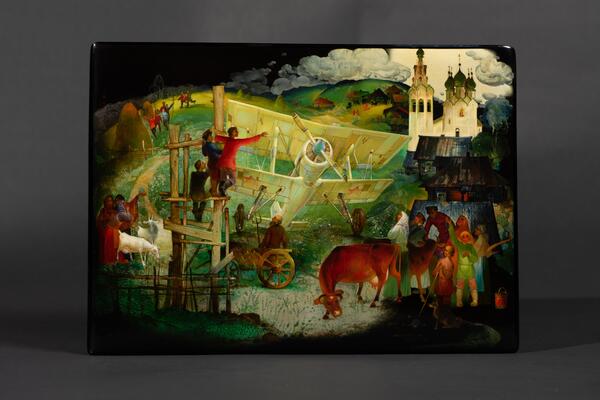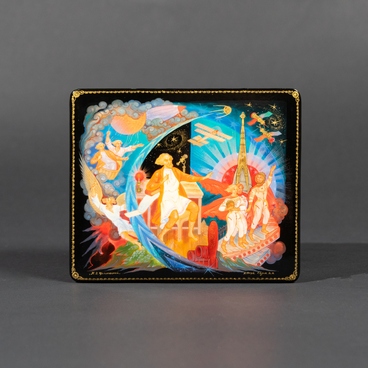Sergey Kozlov is one of the brilliant masters of modern Fedoskino, an Honored Artist of Russia. His work combines a sophisticated technique of miniature painting, an impeccable sense of form and material, and deep imaginative thinking. The artist works in different genres, but he often turns to historical architectural landscapes.
The miniature ‘Wings of the Motherland’ depicts the period when Soviet aviation was being developed. The artist created a work which represents the spirit of the time with its enthusiasm and anticipation of great achievements.
The action in the miniature takes place in a village in the late 1920s — early 1930s. Peasants have cut away from their usual activities and admire the airplane. Most likely, the author captured the flight school of the Osoaviakhim — the Society for the Assistance of Defense, Aircraft and Chemical Construction. It was established in 1929 on a field in the floodplain of a river next to the village of Tushino. A year later, a factory was built next to it, where employees mastered mass production of aircrafts for training future pilots.
The young Soviet state realized how important it was to overcome the backwardness of the country and counted on technological progress. The transformations concerned all spheres of life: the eradication of illiteracy, the modernization of agriculture, the creation of industrial plants. Aviation occupied a special place in the field of technological achievements. The plane became a symbol of the romantic dream of flying coming true and an embodiment of the power of human mind.
In the mid-1920s, the Soviet Union launched a massive campaign to build an air fleet: various organizations raised money for the construction of airplanes. Thus, in 1923, the aircraft called ‘Moscow Bolshevik’, built at the expense of Moscow workers, was transferred to the air fleet.
In those years, the aviation theme inspired many artists and poets. Vladimir Mayakovsky dedicated the poem ‘Aviation Days’ to it:
The miniature ‘Wings of the Motherland’ depicts the period when Soviet aviation was being developed. The artist created a work which represents the spirit of the time with its enthusiasm and anticipation of great achievements.
The action in the miniature takes place in a village in the late 1920s — early 1930s. Peasants have cut away from their usual activities and admire the airplane. Most likely, the author captured the flight school of the Osoaviakhim — the Society for the Assistance of Defense, Aircraft and Chemical Construction. It was established in 1929 on a field in the floodplain of a river next to the village of Tushino. A year later, a factory was built next to it, where employees mastered mass production of aircrafts for training future pilots.
The young Soviet state realized how important it was to overcome the backwardness of the country and counted on technological progress. The transformations concerned all spheres of life: the eradication of illiteracy, the modernization of agriculture, the creation of industrial plants. Aviation occupied a special place in the field of technological achievements. The plane became a symbol of the romantic dream of flying coming true and an embodiment of the power of human mind.
In the mid-1920s, the Soviet Union launched a massive campaign to build an air fleet: various organizations raised money for the construction of airplanes. Thus, in 1923, the aircraft called ‘Moscow Bolshevik’, built at the expense of Moscow workers, was transferred to the air fleet.
In those years, the aviation theme inspired many artists and poets. Vladimir Mayakovsky dedicated the poem ‘Aviation Days’ to it:





